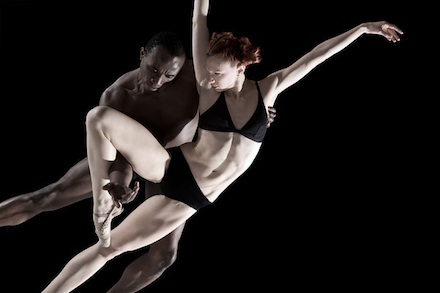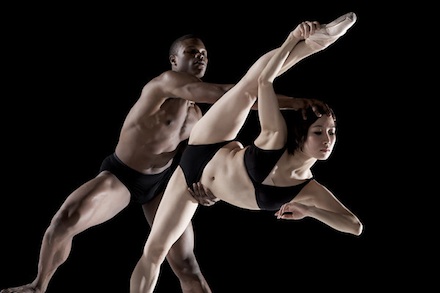
Emily Wagner and William Isaac; photo: Julieta Cervantes It has been said (though the original quipster remains undetermined) that “Talking about music is like dancing about architecture.” So where does that put choreography about physics? Dancers, of course, are bound by physics; force, motion, biomechanics and gravity apply, though the best dancers seem to defy such restrictions. Choreographer Karole Armitage took on a true challenge this year, creating an hour-long dance inspired by physicist Brian Green’s best-seller, The Elegant Universe, about theoretical physics: specifically quantum mechanics, the theory of relativity, and string theory. If this sounds heavy, forget about the cerebral construct; just get to Jacob’s Pillow this weekend to see Armitage Gone! Dance in the bold and beautiful Three Theories. The piece begins without curtains, the stage bare but for a line of lights mid-height against the barn wall. Suddenly these lights flash, blinding the audience; you don’t have to be a rocket scientist to get the allusion to the Big Bang, though anyone up on their 1980s pop trivia would also immediately think of ’s refrain, “She blinded me with science.” From there, Armitage’s dancers are set a-spin, bringing to mind other aspects of physics, namely Newton’s laws about bodies in motion, which deal with velocity, attraction, and momentum.

Or not; no science knowledge, or even knowledge of what this dance purports to be about, is required for you to enjoy Three Theories, which was a pleasant surprise, since some of Armitage’s work has left me cold. Three Theories is hot, helped by Clifton Taylor dramatic lighting, a compelling score, and engrossing, edge-of-your seat choreography. The dancers begin in black bikinis, their diverse, nearly bare bodies suitable canvases for Armitage’s engaging fast-paced formulations. It is tempting to try to figure out how the dance’s arcing, precarious, unpredictable movement might relate to the three theories (tall, pencil-thin Kristina Bethel-Blunt looks like a basketball player when she dances downstage of the diminutive Leonides Arpon, though it’s only relative; she seems to be of normal height when partnered with Luke Manley). But such attempts at deciphering intent are unnecessary.

The dance is filled with unconventionally beautiful movements and moments. Anyone still stuck in the scientific groove would be forgiven for thinking less of theoretical physics and more of particle, or high-energy, physics, which has to do with acceleration and collisions. Splits are executed in all directions, on all planes, on the ground and in even in the air, by a female dancer in her partner’s arms. A repeated motif has a dancer snap into a standing split, anchored by one leg on the floor with the other leg pointed skyward as she sweeps her hands to the floor, opened and folded at the same time like a switchblade; indeed, these dancers are sharp. Late in the dance husky William Isaac provokes a gasp from the audience, snapping to the floor in a split, bouncing up for a second, then snapping down again. Another motif has dancers balanced on one leg fold and grab the other foot, then sensuously extend into an off-center balance. Throughout the piece we clearly see Armitage’s embrace of both balletic tradition and Cunningham-esque eccentricities, a seamless blend of the audience-focused presentation of ballet with the off-centered, oft-awkward asymmetry of Merce Cunningham. Indeed, it is only toward the end of the piece that we notice that three of the five female dancers are en pointe. In one section there’s even a notable flash of jazz dance. By the end of the final section, all the dancers are in white; the transition has been gradual and not jolting, though the bursts of music and intermittent black-outs of the final section do bump up the energy and tension; it’s thrilling. The dance, music bursts, and lighting at seem both coordinated and random; at times, the lights come up to reveal an empty stage; they black out while dancers remain in motion. Throughout, the dancers attack the taxing choreography, but with complete control, with blank faces that exude only defiance, and in the end it is gravity that they appear to defy. “I feel like I just had a lot of great sex,” exclaimed my companion, “and it was really satisfying.” I could agree, at least, with the second part of her assessment. Jacob's Pillow Dance FestivalBecket, MA Through Sunday, July 18








